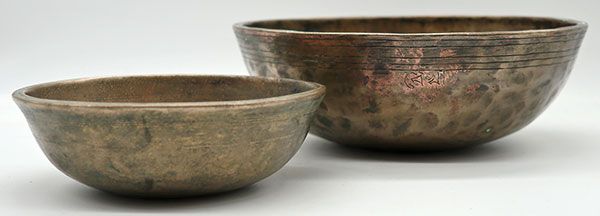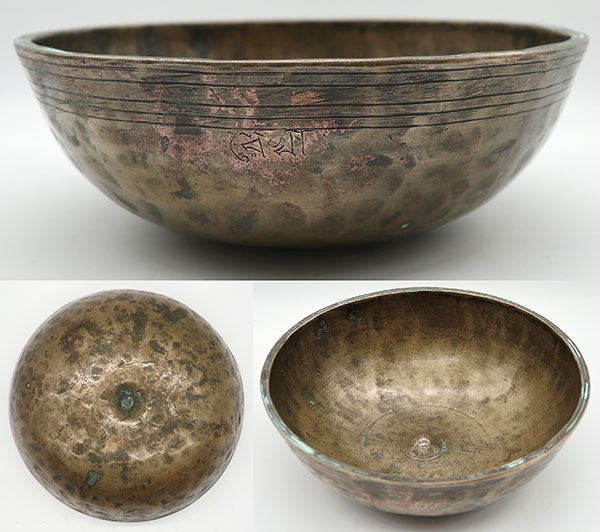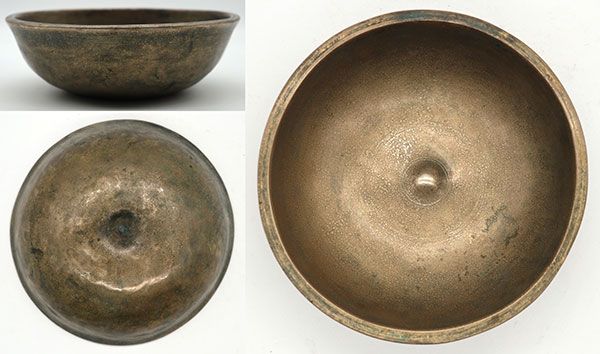Set of 2 Extremely Rare 19th Century Manipuri-Lingam Singing Bowls, CP & Inscription
SOLD
2 Antique Lingam Singing Bowl. Notes G3 & G#3 (Throat Chakra)
918 & 435 grams (2 lb 0 ½ & 15 ¼ oz). 21 x 7.5 & 15.5 x 5 cm (8 ¼ x 3 & 5 ¾ x 2 inches)
2 Antique Lingam Singing Bowl. Notes G3 & G#3 (Throat Chakra)
918 & 435 grams (2 lb 0 ½ & 15 ¼ oz). 21 x 7.5 & 15.5 x 5 cm (8 ¼ x 3 & 5 ¾ x 2 inches)
Antique Lingam Singing Bowls have always been extraordinarily rare, expensive and sought-after, and increasingly so in recent years. They usually take the typical high-walled Thadobati bowl shape, but with a lingam inside and a matching depression (yoni or navel) underneath. Only once in a blue moon would one come across a lingam bowl with a different body form…and almost never a Manipuri. The normal Manipuri bowl form was quite commonplace and readily available until the beginning of this century, since when their supply has virtually dried up.

So, this is an extremely rare opportunity to acquire not one, but two, antique Manipuri-Lingam Singing Bowls…a large one with an 8 ¼ inch diameter, and a small one with a 5 ¾ inch diameter. They were sourced together in the Himalayas and I therefore thought it proper to keep them together as a pair or set.

Both bowls date from the 19th century and are in good structural condition, although the larger of the two shows signs of more use and a little wear and tear.

The larger Manipuri-Lingam has the typical shallow Manipuri shape with a slightly flared and grooved lip and multiple decorative bands encircling the outer rim. There is a large lingam surrounded and defined by circles at its centre, and a deep matching yoni or navel underneath. What appears to be a surface crack underneath is actually a fold in the metal produced at the time of manufacture and has no impact on the integrity of the bowl or its sound. The fundamental note is a perfect concert pitch third octave G3 (196.5Hz) when struck with a padded mallet or played around the rim with a suede ringer. The rim note changes to a fifth octave C#5 (565Hz) with a wooden ringer. This already rare bowl benefits from an even rarer inscription on the outer wall; a sure indication of the importance and high esteem in which it was held by a former keeper.

The second Manipuri-Lingam is very similar in shape and design but smaller and without an inscription. Its fundamental note is a higher middle G#4 (421Hz) when struck and a high sixth octave D6 (1165Hz) when played around the rim with a wooden ringer.
Both bowls have a beautifully aged bronze colour the look and feel of great antiquity.
Two Tibetan silk brocade bowl cushions and ringers are included in the price.
{audio}lingam918.mp3{/audio}
Listen: Manipuri Lingam 918g3 ( 3 struck notes and 2 played notes, suede ringer then wood).
{audio}lingam435.mp3{/audio}
Listen: Manipuri Lingam 455gs4 ( 3 struck notes and 1 played note with wooden ringer)
